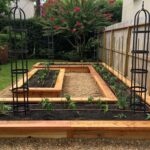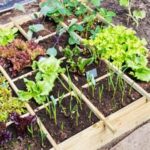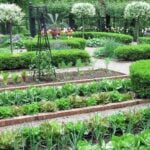Introduction
The benefits of planting a spring vegetable garden in Ohio go beyond providing fresh produce for your family. A well-tended garden will also help to attract beneficial insects and birds, both of which provide natural pest control, enhance pollination and help naturally fertilize the soil. Furthermore, growing vegetables in Ohio during the spring season helps to support local farmers and small businesses, decreasing reliance on large corporate entities for food sources. Finally, a spring vegetable garden provides a chance for exercise, as well as mental health benefits from time spent outdoors away from screens and devices. Plus, it’s an opportunity to spend quality time with friends or family members while taking part in this rewarding hobby!
Local Climate Considerations and Techniques for Successful Gardening
Ohio is known for its temperate climate, making it an ideal spot for a vegetable garden. However, there are certain local climactic considerations that gardeners in this region must take into account when growing vegetables. One factor to consider is the amount of sunlight. Ohio generally enjoys mild temperatures throughout the spring and fall months, as well as sufficient rainfall; however, adequate sunshine is limited during these times. Gardeners in Ohio should plant their vegetable garden in an area that receives at least 6 hours of direct sunlight per day.
Along with placing their vegetable gardens in sunny areas, growers in Ohio should also pay close attention to soil types and conditions when planting their crops. Sandy soils tend to be lightweight and warm quickly, while clay soils can retain moisture better and provide extra nutrients. When selecting a site for the garden, pick one with relatively fertile earth that drains well and allows roots to breathe and grow freely. Additionally, using composted soil amendments can help improve drainage levels and infuse nutrients into the soil. Finally, if possible, planting vegetables alongside trees or shrubs can provide them with additional protection from strong winds. With these tips in mind, Ohio gardeners have the tools needed for a successful spring gardening season!
Ideal Vegetables for Ohio Spring Gardens
Ohio spring vegetable gardens offer a variety of veggies to plant and enjoy. Some of the ideal vegetables for an Ohio spring garden include peas, carrots, onions, radishes, turnips, cauliflower, broccoli and cabbage. These vegetables are all low maintenance and tolerate cool weather well. Peas can be started from seed in early spring when the soil is still slightly cool. Carrots should be sowed directly into the ground about two weeks before the last frost date for your area. Onions can be planted as sets or transplants which have been grown inside up until planting time in early spring. Radishes also benefit from direct sowing into the garden when the soil is cool. Turnips should be started indoors and transplanted out in early spring as they can tolerate cold temperatures but need longer to mature than quick-growing crops like radishes. Cauliflower, broccoli and cabbage all require a longer growing season than other vegetables so they should be started indoors a few weeks before you plan on transplanting them out in late April or May after danger of frost has passed.
Plan and Layout of the Garden – An Essential Step
Planning and laying out an Ohio spring vegetable garden is an essential step in growing a successful and thriving garden. The amount of space available, the plants chosen, and the accessibility to sunlight are all important factors to consider when planning your layout. First, measure out the area you intend to use and mark off any pathways or boundaries. Secondly, determine which vegetables you would like to grow based on the amount of space available. Thirdly, be sure that each vegetable has enough room to reach its full size without overcrowding other plants. Finally, be mindful of how much sun each plant requires and make sure that the area receives adequate sunlight for those vegetables to thrive. With careful planning, you can plan out a well-organized and efficient Ohio spring vegetable garden that will yield high-quality produce for seasons to come!
Getting Started – Recommended Seeds, Supplies, and Tools
Ohio spring vegetable gardens can be incredibly rewarding, providing fresh produce for many months to come! To get started on your garden, you will need a few essential supplies and tools. You’ll need to collect the appropriate soil, fertilizer, gardening tools, and seeds.
Depending on what vegetables you want to plant, it’s important to purchase the correct type of seed – either organic heirloom (non-GMO) or hybrid seeds. Heirloom seeds are especially desirable as they retain their natural genetic diversity. When shopping for gardening supplies, always check with your local garden center or online retailers for their variety of options available.
In order to keep your Ohio spring vegetable garden healthy and thriving, you will also need some gardening essentials such as watering cans, hoses, and sprinklers for irrigation; gloves and trowels for digging; wheelbarrows or wagons for transporting soil and plants; hand pruners and clippers for trimming; stakes and cages for support; rakes or shovels for weeding; composters and tons to condition the soil if needed; birdhouses or barricades if necessary; mulch and landscaping fabric or plastic sheeting to protect your garden from weeds. You may also consider investing in a grow light system so that you can extend your growing season into colder temperatures when needed. Finally, remember to always read product labels carefully so that you know how to properly use the products in your Ohio spring vegetable garden!
Caring for and Managing the Garden
Once you’ve planted your Ohio Spring Vegetable Garden, the next step is to properly care for and manage the garden in order to ensure good yields. Start by watering plants regularly, making sure they get enough moisture but also are not over-watered. Monitor the temperature in your garden area, as many vegetables will struggle if grown in overly hot weather. Weed the garden frequently and keep an eye out for pests or diseases that may affect your crops. Implement appropriate pest control methods when necessary. If needed, cover the soil with mulch or plastic sheeting to help conserve moisture. Finally, fertilize your Ohio Spring Vegetable Garden with a balanced fertilizer according to package instructions. With proper care and management, you can be sure of healthier plants and higher yields from your Ohio Spring Vegetable Garden.
What to Expect – Tips for Handling Common Pests and Diseases
When planting a vegetable garden in Ohio during spring, there are many factors to consider. One of the most important is how to handle the common pests and diseases that can affect your plants. Depending on the type of vegetables you are planting, some of the issues you need to be prepared for include aphids, cucumber beetles, tomato hornworms, powdery mildew, leaf spot or blight, and root rot.
To prevent or treat these common pests and diseases it is important to understand what specific plants tend to attract them. Depending on the plant being affected you may want to use different preparation tactics like floating row covers for cucurbit family crops or insecticidal soap for some early season insects. In addition, crop rotation through alternating rows of vegetation can help reduce soilborne diseases while pruning away dead plant tissues can reduce chances of other fungal infections such as powdery mildew. Planting both companion plants and flowers nearby can provide natural pest control as certain flowers may repel damaging bugs while certain veggies lure beneficial predators who feed on common garden pests. Finally, being vigilant and staying on top of any potential threats with early detection is key in taking control without having to resort to heavy chemical solutions that could potentially harm beneficial pollinators as well as your future edible harvest!
Seasonal Plant Varieties to Plant in Ohio
An Ohio spring vegetable garden can be a joy to behold. Planting a variety of seasonal vegetables in your garden will ensure you get a bountiful harvest. Some of the most popular varieties for an Ohio spring vegetable garden include kale, spinach, radishes, carrots, lettuce, celery, Swiss chard, turnips, beets and onions. It is also recommended to plant bush beans and summer squash such as zucchini or yellow crookneck squash as well. When planning your Ohio spring vegetable garden layout it’s important to keep in mind that some plants need full sun while others should be planted in partial shade so make sure you research the specific requirements for each species before planting them. Additionally, you should plan for succession plantings of certain amounts at different times throughout the season to have veggies well into the summer months. You can take advantage of early spring planting with cool weather crops like peas and lettuce so they will be ready when it warms up. Later on add those fruits that require more time after a frost has passed like tomatoes and cucumbers. If you have limited space or no yard consider investing in some pots or window boxes so you are still able to grow something! An Ohio spring vegetable garden is sure to be an enjoyable experience as long as you plan accordingly!
Wrapping Up
Once you have planted your seedlings, taken care of your garden, and watched it grow over the long spring season, now it’s time to reap the rewards! Depending on what vegetables you decide to plant, you can enjoy a flavor-filled harvest over the following weeks. Different veggies will be ready to pick at different times of the year so make sure to plan out what to pick and when. If everything goes well with your Ohio spring vegetable garden you should be able to collect an abundance of produce including lettuces, tomatoes, peppers, cucumbers, squash and beans. Be sure to use all of your veggies right away as most of them are best when freshly picked. Enjoy experimenting and cooking with new recipes so that you can fully savor all of the fresh flavors that come with homegrown produce. Additionally, sharing your bounty with family and friends is a great way to spread positivity in this challenging time. Whether it’s gifting bags of apples or inviting someone over for a home cooked meal using ingredients from your garden – connecting people with nature through food is a truly magical experience!

If you’re looking to get into vegetable gardening, or are just looking for some tips on how to make your current garden better, then you’ve come to the right place! My name is Ethel and I have been gardening for years. In this blog, I’m going to share with you some of my best tips on how to create a successful vegetable garden.





